>
Eupercaria/misc (Various families in series Eupercaria) >
Scaridae (Parrotfishes) > Scarinae
Etymology: Scarus: Greek, skaros = a fish described by anciente writers as a parrot fish; 1601 (Ref. 45335); fuscocaudalis: Named in reference to the dark color of the large central portion of the caudal fin of the initial phase (Ref. 40928).
More on authors: Randall & Myers.
Environment: milieu / climate zone / depth range / distribution range
Ecologia
marino associati a barriera corallina; distribuzione batimetrica 20 - 45 m (Ref. 90102). Tropical
Distribuzione
Stati | Aree FAO | Ecosystems | Presenze | Point map | Introduzioni | Faunafri
Indo-West Pacific: Ryukyu Islands, Philippines, and Guam. Records from Indonesia and Papua New Guinea are questionable and confirmation is needed.
Size / Peso / Age
Maturity: Lm ? range ? - ? cm
Max length : 25.0 cm TL maschio/sesso non determinato; (Ref. 48636)
Short description
Morfologia | Morfometria
Spine dorsali (totale): 9; Raggi dorsali molli (totale): 10; Spine anali 3; Raggi anali molli: 9; Vertebre: 25. Presence of 4 median predorsal scales; 3 rows of scales on cheek, the upper row with 6-7 scales, the middle row with 6 scales, and the lower row with 1 or 2 scales; 1 or 2 laterally projecting canines posteriorly on side of dental plates of adults; lips covering more than 3/4 of dental plates; dorsal fin moderately high, the longest dorsal spine 2.1-2.6 in head length; caudal fin truncate in young, double marginate in initial-phase fish, and somewhat lunate in terminal males. Initial phase fish brownish pink to rose pink, the throat and thorax green with green stripes extending posteriorly across abdomen; naked part of caudal fin blackish with orange lobes and a broad whitish posterior margin; body of terminal males pink and green, with blue and pink stripes ventrally; head blue with pink stripes ( a broad one on snout passing through lower eye to pectoral-fin base, and another from behind eye across upper part of operculum); naked part of caudal fin purple centrally, green posteriorly, the lobes blue with a pink submarginal band.
Found in coastal to outer reef crests and along drop-offs, usually in small groups (Ref. 48636); occurs at depths greater than 20 m (Ref. 40928).
Life cycle and mating behavior
Maturità | Riproduzione | Deposizione | Uova | Fecundity | Larve
Oviparous, distinct pairing during breeding (Ref. 205).
Parenti, P. and J.E. Randall, 2000. An annotated checklist of the species of the labroid fish families Labridae and Scaridae. Ichthyol. Bull. J.L.B. Smith Inst. Ichthyol. (68):1-97. (Ref. 35918)
IUCN Red List Status (Ref. 130435)
Threat to humans
Harmless
Human uses
Informazioni ulteriori
Age/SizeAccrescimentoLength-weightLength-lengthLength-frequenciesMorfometriaMorfologiaLarveDinamica popolazioni larvaliReclutamentoAbbondanzaBRUVS
BibliografiaAcquacolturaProfilo di acquacolturaVarietàGeneticaElectrophoresesEreditarietàMalattieElaborazioneNutrientsMass conversion
CollaboratoriImmaginiStamps, Coins Misc.SuoniCiguateraVelocitàModalità di nuotoArea branchialeOtolithsCervelliVista
Strumenti
Special reports
Download XML
Fonti Internet
Estimates based on models
Preferred temperature (Ref.
123201): 24.4 - 28.5, mean 27.4 °C (based on 70 cells).
Phylogenetic diversity index (Ref.
82804): PD
50 = 0.5000 [Uniqueness, from 0.5 = low to 2.0 = high].
Bayesian length-weight: a=0.01023 (0.00436 - 0.02401), b=3.09 (2.90 - 3.28), in cm total length, based on LWR estimates for this Genus-body shape (Ref.
93245).
Resilienza (Ref.
120179): Alto, tempo minimo di raddoppiamento della popolazione meno di 15 mesi (Preliminary K or Fecundity.).
Fishing Vulnerability (Ref.
59153): Low vulnerability (15 of 100).
Nutrients (Ref.
124155): Calcium = 62 [35, 108] mg/100g; Iron = 0.828 [0.529, 1.410] mg/100g; Protein = 18 [16, 20] %; Omega3 = 0.0631 [, ] g/100g; Selenium = 22.8 [11.3, 42.2] μg/100g; VitaminA = 52.1 [13.0, 208.3] μg/100g; Zinc = 2.63 [1.86, 3.63] mg/100g (wet weight);
